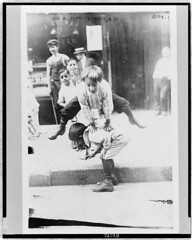Sometimes, using more than one POV in a novel can be tricky. Handling multiple POV styles can be even trickier. Today we’ll look at how to transition effectively between multiple POV characters in third person, and next time we’ll take it to the next level, looking at multiple first person narrators and mixing first and third.

Multiple third-person POV characters
In general, the guideline is that we don’t change POV characters within a scene. I’ve even seen this rule phrased as “you can’t change POV characters within a chapter” but from all that I’ve read and seen, I think that’s far stricter than general publishing guidelines. I’ve also seen some writers state that you can’t change POVs within a chapter, but that’s patently ridiculous, to put it mildly.
When changing between viewpoint characters with all third-person POVs, you will want to use a scene break (denoted by white space or other marks in novels, denoted by centered asterisks or octothorpes in manuscripts) or a chapter break. As with any scene ending, you’ll probably want to give us something to look forward to for the next time we see that character or we get that character’s POV (a hook, if you will).
In the new scene, orient the readers to the new POV character as quickly as you can. You have a number of options of narrative modes to start the scene, but orienting to the POV character can make it a little tougher. Using dialogue can be hit or miss. Thoughts, in general—such as the sequel from the previous scene in this character’s POV—aren’t the best way to switch off the POVs.
I think of opening with thoughts like starting a movie scene with a black screen and a voiceover—without the advantage of recognizing the voice right away. There’s a certain stark effect there, but if you’re not going for that, use the anchor and marble in those thoughts amid the present action.
 The easiest way to orient the reader to the new POV character is to begin with a physical action anchor. I do try to avoid falling into a formula, but this beginning is also a good place to orient the reader and character in place and time, include a short sequel from the last scene we saw the POV character in (especially if something important happened and we need their reaction) and state the scene goal (which is often related to the sequel).
The easiest way to orient the reader to the new POV character is to begin with a physical action anchor. I do try to avoid falling into a formula, but this beginning is also a good place to orient the reader and character in place and time, include a short sequel from the last scene we saw the POV character in (especially if something important happened and we need their reaction) and state the scene goal (which is often related to the sequel).
Seems like a lot? You can do all that in as little as three sentences.
Another personal rule that I use with multiple POV characters (and this is totally my option, a guideline I gave myself, you don’t have to follow it, but I do) is that any character whose role in the story is important enough to warrant getting their own POV should probably have their POV introduced within the first 3-5 chapters or 30-50 pages.
I find POV characters that jump out of nowhere jarring, especially later in a book (especially if it’s for a single scene—drive-by POV—and most especially if that single scene isn’t needed or didn’t need an additional POV character). They don’t have to come up in a regular rotation, but I try to keep the “minor viewpoint characters” in the loop every few chapters as well.
Multiple third-person POVs within a single scene
 Seriously? Didn’t I just say we shouldn’t do this?
Seriously? Didn’t I just say we shouldn’t do this?
All right, that doesn’t mean it doesn’t happen in published books. At this point, I avoid this (I’m very strict on myself about POV, actually). But if you really, really, really want to do it, here are some tips:
- Make sure the transition is necessary. Gratuitous changes can feel like indiscriminate head hopping. Limit the number of heads you pop into in a single scene
- Make sure the transition is obvious (i.e. obviously intentional). The reader needs to feel like we’ve passed the POV baton onto this new character and the character has accepted it, not like “we’re just in this character’s head for a visit, and then we’ll pop back into the real POV character’s head.”
- Make sure the transition is smooth. (Obvious and smooth? I’m not asking much, right? Maybe this is why this has fallen out of favor.)
This is not quite like omniscient POV, because in omniscient, you don’t have to be quite so strict about transitions. You want to be systematic in omniscient, but once you’ve established your POV expectations (that you can dip into all characters’ thoughts), you can continue to operate in those parameters.
Unless you’re already published, you have to prove you know what you’re doing with POV, so tread carefully here.
What do you think? What “person” do you typically use? How many viewpoint characters do you typically have? What is the most you’ve ever juggled? Come join in the conversation!
Photo credits: couple eating—Mr. Thomas;
anchor & compass (Falkland Islands War Memorial)—Ambernectar 13; leap frog (for head hopping)—TRiver
